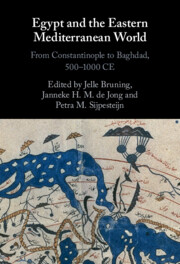Book contents
- Egypt and the Eastern Mediterranean World
- Egypt and the Eastern Mediterranean World
- Copyright page
- Contents
- Figures, Graphs, and Tables
- Notes on Contributors
- Notes on Transliteration, Names, and Dates
- Preface and Acknowledgments
- Additional material
- Introduction
- Part I Political and Administrative Connections
- Part II Economic Connections
- Chapter 7 Between Ramla and Fusṭāṭ: Archaeological Evidence for Egyptian Contacts with Early Islamic Palestine (Eighth–Eleventh Centuries)
- Chapter 8 Egypt’s Connections in the Early Caliphate: Political, Economic, and Cultural
- Chapter 9 Trading Activities in the Eastern Mediterranean through Ceramics between Late Antiquity and Fatimid Times (Seventh–Tenth/Eleventh Centuries)
- Part III Social and Cultural Connections
- Index
- References
Chapter 9 - Trading Activities in the Eastern Mediterranean through Ceramics between Late Antiquity and Fatimid Times (Seventh–Tenth/Eleventh Centuries)
from Part II - Economic Connections
Published online by Cambridge University Press: 01 December 2022
- Egypt and the Eastern Mediterranean World
- Egypt and the Eastern Mediterranean World
- Copyright page
- Contents
- Figures, Graphs, and Tables
- Notes on Contributors
- Notes on Transliteration, Names, and Dates
- Preface and Acknowledgments
- Additional material
- Introduction
- Part I Political and Administrative Connections
- Part II Economic Connections
- Chapter 7 Between Ramla and Fusṭāṭ: Archaeological Evidence for Egyptian Contacts with Early Islamic Palestine (Eighth–Eleventh Centuries)
- Chapter 8 Egypt’s Connections in the Early Caliphate: Political, Economic, and Cultural
- Chapter 9 Trading Activities in the Eastern Mediterranean through Ceramics between Late Antiquity and Fatimid Times (Seventh–Tenth/Eleventh Centuries)
- Part III Social and Cultural Connections
- Index
- References
Summary
Two major questions are crucial for understanding the historical development(s) of Egypt after antiquity. The first one is: How was Egypt embedded in larger structures and developments in the eastern Mediterranean from late Roman times onward? The second one is: How did Egypt operate within these larger networks? In order to address these questions from an archaeological perspective, I set out to take a new look at aspects of the material culture in Egypt during the late antique and early Islamic periods, using a bottom-up perspective. More precisely, it is my intention to discuss both the production and the regional distribution of some of the most widely used pottery types in Egypt from around the seventh to the tenth/eleventh centuries, as well as the medium- and long-distance movements of these ceramic products in the eastern Mediterranean and beyond.1
- Type
- Chapter
- Information
- Egypt and the Eastern Mediterranean WorldFrom Constantinople to Baghdad, 500-1000 CE, pp. 272 - 322Publisher: Cambridge University PressPrint publication year: 2022

